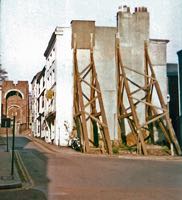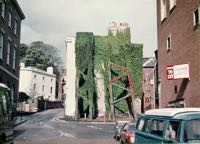
 Castle
Street and Little Castle Street
Castle
Street and Little Castle Street
Page updated 16th February 2018
 The old street known
as Little
Castle Street that led from
the High Street to Rougemont Castle was replaced by a wider, parallel
Castle Street in 1772. Before Castle Street was cut, and the gatehouse
was approached from Little Castle Street, there was a ditch or fosse in
front of the entrance with a bridge over.
The old street known
as Little
Castle Street that led from
the High Street to Rougemont Castle was replaced by a wider, parallel
Castle Street in 1772. Before Castle Street was cut, and the gatehouse
was approached from Little Castle Street, there was a ditch or fosse in
front of the entrance with a bridge over.
Castle Street was on the route taken after a new Mayor was sworn in, when he walked the city walls. He entered from the Castle, passed down Castle Street and on to Eastgate as the city wall in that section was not accessible. During the Assizes, Castle Street would be full of people to watch the comings and goings to the court in the Castle Yard.
A dental hospital opened in Castle Street in 1880, and by 1895, it had treated 5,214 patients. During the same period, the keeper of Exeter Castle, William Peter lived in the street. The Register of Births and Deaths was based in the street, just as it is today, although entered from New Buildings Street.
World War One Dead - Castle Street
Serjeant,
Basil George Buckland, Machine Gun Corps (Infantry). 8 October 1918.
Age 21. Rougemont House, Castle St
Lance Corporal, James Ernest
Camble, Cheshire Regiment. Died of wounds 17 February 1917. Age 25.
Castle St
The lost hotel
The block of buildings between Castle Street and Little Castle Street, was headed by the Castle Hotel at the lower end. The hotel was damaged during the May 1942 blitz, but remained in situ, with one casualty Henry George William Tremlett, aged 46 was injured and died at the Royal Devon and Exeter Hospital on the 11 May 1942. All the shops along the High Street, on each side of the junction with Castle Street were destroyed in the bombing.
Work started in 1948 to lay the sewers and other services in the area, and by the early 1950s the wall along Bailey Street was strengthened and consolidated, and the remains of the Castle Hotel were demolished. The wall of the building above the hotel had massive, wooden buttressing put in place. The Westminster Bank was constructed in 1951 on the corner of Castle Street and High Street and Marks & Spencer's new store was built on the opposite corner. The road levels into Little Castle Street were rather awkward and some care was taken to ensure the approach was not too steep.
The buttressing became a feature of Castle Street and the Virginia Creeper a welcome addition to the bare timber. In the late 1980s, the buttressing was removed and a rather attractive retail unit, that was initially occupied by the fashion store Monsoon, was built on the site of the former Castle Hotel. It became Michael Spiers Jewellers and is now a centre for cosmetic dentistry.
The city library was opened in October 1930 at a
cost of £55,000. Situated on the opposite side of Castle Street to the Castle Hotel, it was
burnt out, with the loss of a million
county books and documents in the 1942 bombing, but was restored after
the war and extended in the 1960s.
A pub and restaurant called the Hole in the Wall, said to be the
first Berni Inn in the city, can be found in
the
very narrow Little Castle Street. This street has not changed much
since the nineteenth-century.
Sources:Exeter, The Blitz and Rebirth of the City by Norman Venning, Reminiscences of Exeter by James Cossins.

After the remains of the Castle Hotel were removed, they buttressed the party wall to prevent it collapsing.
│ Top of Page │






